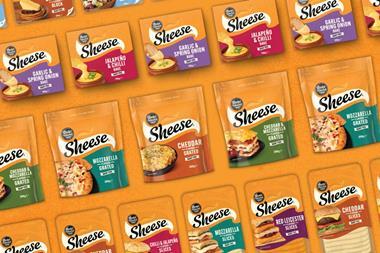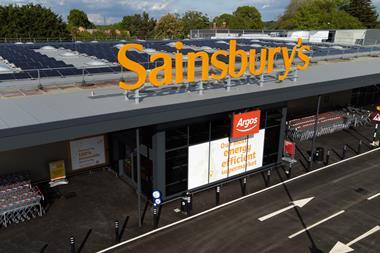Availability, sharp pricing and solid working with suppliers may be pulling Sainsbury around says Rachel Barnes
For Sainsbury, life has tasted a bit better in 2005. It’s re-signed man-of-the-moment Jamie Oliver and morale is riding high ahead of its May 18 end-of-year results.
If its fourth-quarter results for the 12 weeks to March 26 are anything to go by, then things are looking up. Total sales, including petrol, were up 7.2%. Burrow slightly deeper and like-for-likes, excluding petrol, reveal a not-so-impressive 1.7% uplift compared with a 0.9% dip for the same period last year.
So has the multiple really turned the corner? Last year was undoubtedly Sainsbury’s year from hell, with three profit warnings. The company that was once making profits of around £700m dropped the bombshell that this figure had plunged to losses of £39m.
Trading director Mike Coupe, the former Iceland MD who joined Sainsbury last November, is keen not to get carried away with talk of recovery. “We’re only in our first quarter of growth, so we must remember to temper our excitement and enthusiasm.
“Our biggest focus remains getting availability right and we’ve made a fair degree of progress, which has been demonstrated in the numbers we’ve reported. On the back of that, our offer is now superior and from a customer point of view, we’ve made significant price moves.”
Sainsbury cut the prices of 6,000 products across its stores last year. And this year it has already reduced 1,000 prices, although Coupe will not be drawn on how many more are to come in 2005 - a year in which Tesco and Asda have already knocked a combined £167m off prices. But he does hint at more reductions, saying Sainsbury cannot afford to drop the ball: “It’s become a hugely competitive market; you can’t survive unless you keep up.”
Other initiatives include its latest Corporate Social Responsibility programme, Active Kids. Already more than 20,000 schools have registered for the voucher scheme, which enables schools to receive sports equipment. Getting back into the public’s good books is key to Sainsbury’s
turnaround, whether by leveraging CSR, or other upcoming drives, such as a big push behind organic later this year. Although CSR may not translate directly into sales, rallying communities to collect vouchers does.
Gavin Rothwell, senior retail analyst at Verdict Research, agrees that - especially when there’s talk of a backlash against the might of Tesco - Sainsbury could win in the image stakes. “There’s definitely an opportunity to promote itself as a friendly store, which will go down well with consumers.” But, he concedes, “none of this makes a bit of difference if it hasn’t got the products on shelves”. Availability, as Coupe says, is still top of the agenda. And he’s right that progress is being made, as The Grocer 33 shows. In the six months to December 14, Sainsbury’s record for availability was poor. It came last in our survey with 94.7% availability - losing out to Somerfield, Waitrose, Safeway and Morrisons as well as Tesco and Asda. However, availability for the 17 weeks to April 30 rose to 95.6%.
“Sainsbury has come a long way already in terms of pricing and availability,” says Rothwell. “But there are still improvements to be made.” Rothwell is also impressed with the new Basics range, which has plugged the gap at its entry-level price point with an inclusive offer rather than a downmarket range.
Getting price points spot on is central to rejuvenating the Sainsbury offer. In order to define further its good, better, best range hierarchy, an 18-month total product review has kicked off every one of its 55 categories in both food and non-food. The intention, says Coupe, is to rationalise some areas while bolstering others, with the overall aim of ensuring that, as well as getting product on shelves, it has the ranges people actually want.
Sainsbury is also determined to make sure suppliers believe in its turnaround strategy. And many suppliers have been voicing support for the multiple, despite recent unrest in the ranks. In March, King accused suppliers of “acting like there’s nothing wrong”. Back in January, supplier realtionships were truly tested after Sainsbury announced delayed payment terms on top of non-negotiable demands for lower prices.
Part of Sainsbury’s focus on suppliers has involved creating business plans for its top 200 suppliers, to set out a clear, concise working relationship from the outset. “We want to create an open and honest dialogue and communicate with suppliers at every possible opportunity,” says Coupe. “We’ve written up joint business plans with our biggest suppliers that both parties have signed up to. This means our plans are aligned to our strategic objectives. It’s about a joint understanding of what our commercial relationship is upfront.”
Further good news comes from Investec Securities, which has bucked the trend for placing negative recommendations on Sainsbury’s shares. Its contrary view, outlined in February before quarter four’s uplift, said the grocer was undervalued and consensus underestimated its potential for margin through sales momentum.
With all the positive signs around Sainsbury at the moment, it’s easy to get caught up in the swirl. However, it is still just one year into a three-year turnaround plan.
Richard Ratner, head of equities for Seymour Pierce, urges for a balanced view to be taken. “Yes, its results were a lot better, but its pricing strategy has an effect on the bottom line. CEO Justin King is going for top-line growth, which can do a lot of damage to profits. It’s done at a cost, but saying that, Justin is a good egg. And he’s doing many of the right things.”
For Sainsbury, life has tasted a bit better in 2005. It’s re-signed man-of-the-moment Jamie Oliver and morale is riding high ahead of its May 18 end-of-year results.
If its fourth-quarter results for the 12 weeks to March 26 are anything to go by, then things are looking up. Total sales, including petrol, were up 7.2%. Burrow slightly deeper and like-for-likes, excluding petrol, reveal a not-so-impressive 1.7% uplift compared with a 0.9% dip for the same period last year.
So has the multiple really turned the corner? Last year was undoubtedly Sainsbury’s year from hell, with three profit warnings. The company that was once making profits of around £700m dropped the bombshell that this figure had plunged to losses of £39m.
Trading director Mike Coupe, the former Iceland MD who joined Sainsbury last November, is keen not to get carried away with talk of recovery. “We’re only in our first quarter of growth, so we must remember to temper our excitement and enthusiasm.
“Our biggest focus remains getting availability right and we’ve made a fair degree of progress, which has been demonstrated in the numbers we’ve reported. On the back of that, our offer is now superior and from a customer point of view, we’ve made significant price moves.”
Sainsbury cut the prices of 6,000 products across its stores last year. And this year it has already reduced 1,000 prices, although Coupe will not be drawn on how many more are to come in 2005 - a year in which Tesco and Asda have already knocked a combined £167m off prices. But he does hint at more reductions, saying Sainsbury cannot afford to drop the ball: “It’s become a hugely competitive market; you can’t survive unless you keep up.”
Other initiatives include its latest Corporate Social Responsibility programme, Active Kids. Already more than 20,000 schools have registered for the voucher scheme, which enables schools to receive sports equipment. Getting back into the public’s good books is key to Sainsbury’s
turnaround, whether by leveraging CSR, or other upcoming drives, such as a big push behind organic later this year. Although CSR may not translate directly into sales, rallying communities to collect vouchers does.
Gavin Rothwell, senior retail analyst at Verdict Research, agrees that - especially when there’s talk of a backlash against the might of Tesco - Sainsbury could win in the image stakes. “There’s definitely an opportunity to promote itself as a friendly store, which will go down well with consumers.” But, he concedes, “none of this makes a bit of difference if it hasn’t got the products on shelves”. Availability, as Coupe says, is still top of the agenda. And he’s right that progress is being made, as The Grocer 33 shows. In the six months to December 14, Sainsbury’s record for availability was poor. It came last in our survey with 94.7% availability - losing out to Somerfield, Waitrose, Safeway and Morrisons as well as Tesco and Asda. However, availability for the 17 weeks to April 30 rose to 95.6%.
“Sainsbury has come a long way already in terms of pricing and availability,” says Rothwell. “But there are still improvements to be made.” Rothwell is also impressed with the new Basics range, which has plugged the gap at its entry-level price point with an inclusive offer rather than a downmarket range.
Getting price points spot on is central to rejuvenating the Sainsbury offer. In order to define further its good, better, best range hierarchy, an 18-month total product review has kicked off every one of its 55 categories in both food and non-food. The intention, says Coupe, is to rationalise some areas while bolstering others, with the overall aim of ensuring that, as well as getting product on shelves, it has the ranges people actually want.
Sainsbury is also determined to make sure suppliers believe in its turnaround strategy. And many suppliers have been voicing support for the multiple, despite recent unrest in the ranks. In March, King accused suppliers of “acting like there’s nothing wrong”. Back in January, supplier realtionships were truly tested after Sainsbury announced delayed payment terms on top of non-negotiable demands for lower prices.
Part of Sainsbury’s focus on suppliers has involved creating business plans for its top 200 suppliers, to set out a clear, concise working relationship from the outset. “We want to create an open and honest dialogue and communicate with suppliers at every possible opportunity,” says Coupe. “We’ve written up joint business plans with our biggest suppliers that both parties have signed up to. This means our plans are aligned to our strategic objectives. It’s about a joint understanding of what our commercial relationship is upfront.”
Further good news comes from Investec Securities, which has bucked the trend for placing negative recommendations on Sainsbury’s shares. Its contrary view, outlined in February before quarter four’s uplift, said the grocer was undervalued and consensus underestimated its potential for margin through sales momentum.
With all the positive signs around Sainsbury at the moment, it’s easy to get caught up in the swirl. However, it is still just one year into a three-year turnaround plan.
Richard Ratner, head of equities for Seymour Pierce, urges for a balanced view to be taken. “Yes, its results were a lot better, but its pricing strategy has an effect on the bottom line. CEO Justin King is going for top-line growth, which can do a lot of damage to profits. It’s done at a cost, but saying that, Justin is a good egg. And he’s doing many of the right things.”








No comments yet